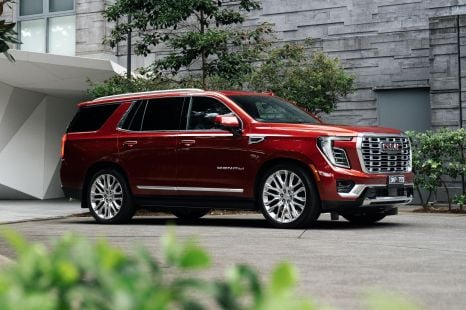

William Stopford
3 Months Ago
While it's something of a living fossil in the modern automotive landscape, the V8 petrol-powered Patrol still has a lot going for it – but damn she's thirsty.
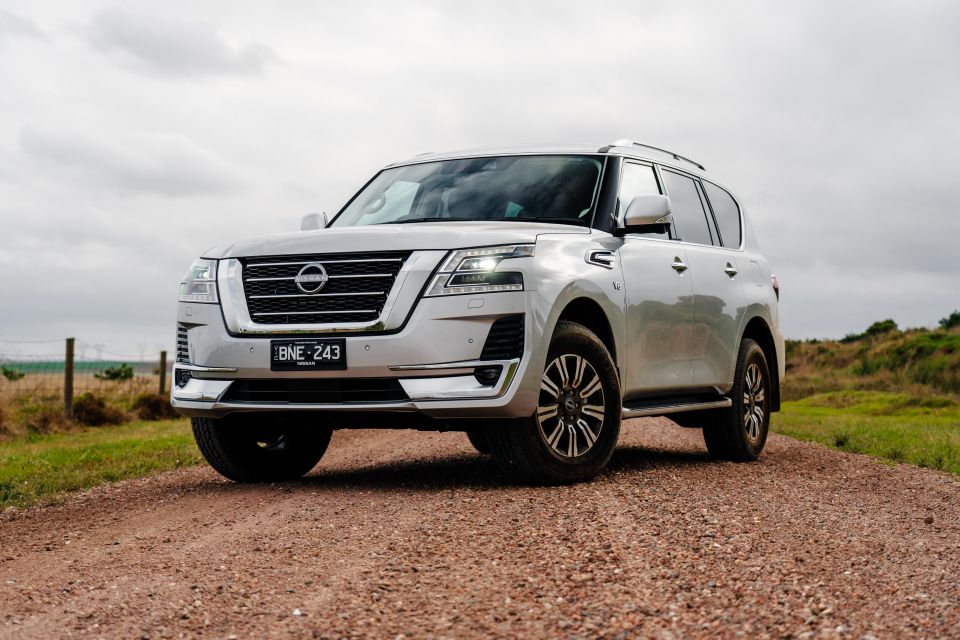
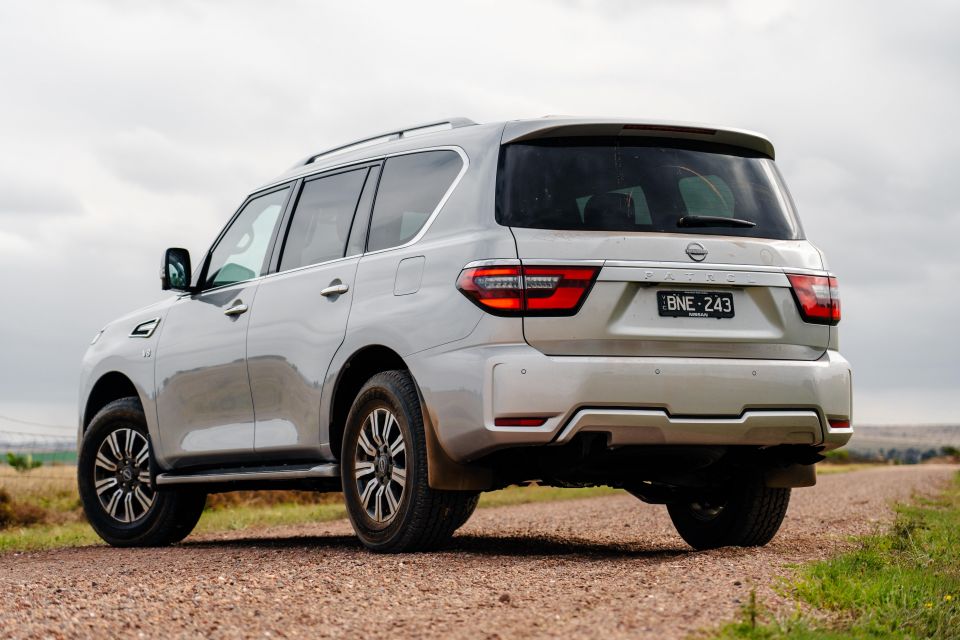

Quickly see how this car stacks up against its competition. Select any benchmark to see more details.
Take advantage of Australia's BIGGEST new car website to find a great deal on a Nissan Patrol.
Same same, but slightly different.
The 2022 Nissan Patrol has landed in Australia, and while there was a media release announcing the arrival of the Japanese brand’s updated luxury off-roader not much has changed.
Headlining the changes for 2022 are the application of a new, flat Nissan logo design which will gradually roll out across its line-up, and some darkened trim pieces on the front intakes and grille. That’s about it.

Unfortunately, we still don’t get the updated interior from the US-market Nissan Armada which is essentially the same car but in left-hand drive, meaning we miss an updated infotainment system with tech like Apple CarPlay and Android Auto.
With that said, the Patrol is still steaming along in the sales race, setting an all-time Australian sales record in March 2022. With Toyota’s new LandCruiser 300 crippled by production delays and supply shortages, Aussie adventurers are walking into Nissan showrooms to buy this hulking V8 petrol-powered beast.
Not much has changed, but it’s worth seeing how the Nissan Patrol stacks up in 2022?
On test we have the top-spec 2022 Nissan Patrol Ti-L which lists for $95,115 plus on-road costs.
That’s no small sum of money, but when you consider you can have a fully-loaded Patrol for the same or less money than a mid-spec LandCruiser 300 GXL or low-grade versions of a Land Rover Defender or Discovery, you’re getting a lot of car for you money.
The range opens even lower, with the entry-level Patrol Ti asking for $82,160 before on-roads with the same drivetrain and a still healthy level of standard equipment. It’s even cheaper than a base Volkswagen Touareg.
2022 Nissan Patrol pricing:
Prices exclude on-road costs
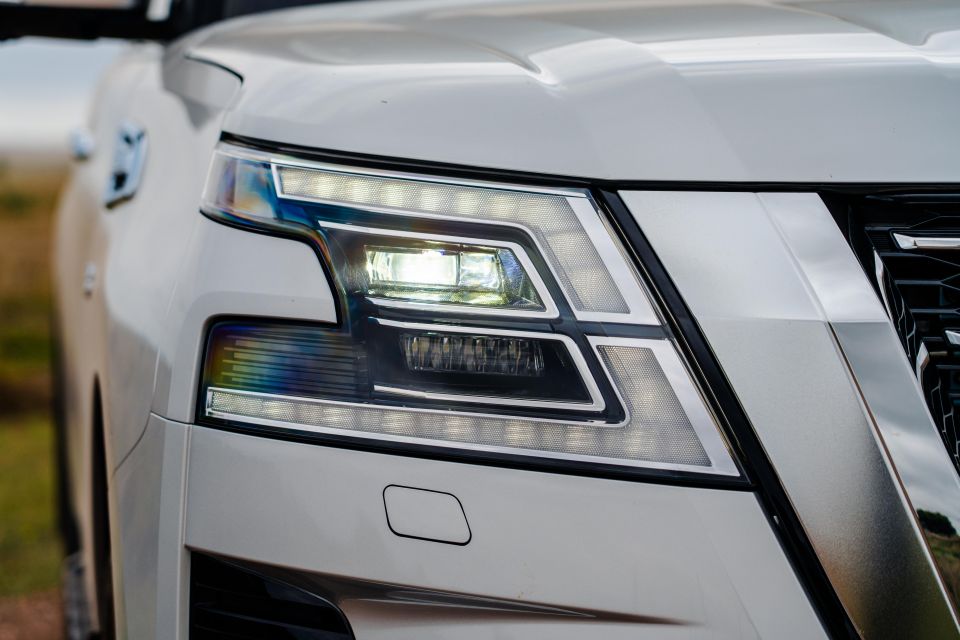
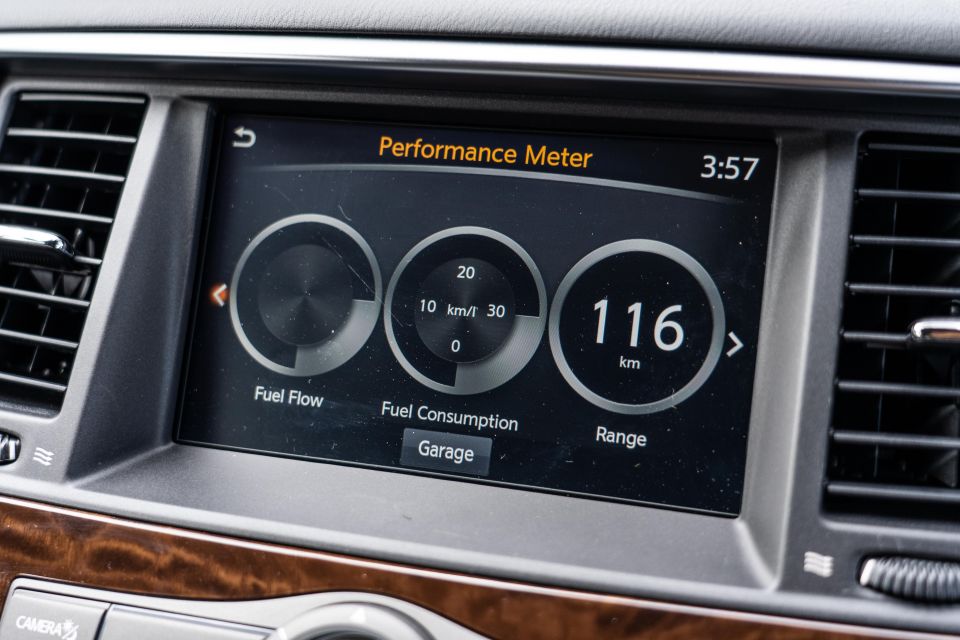
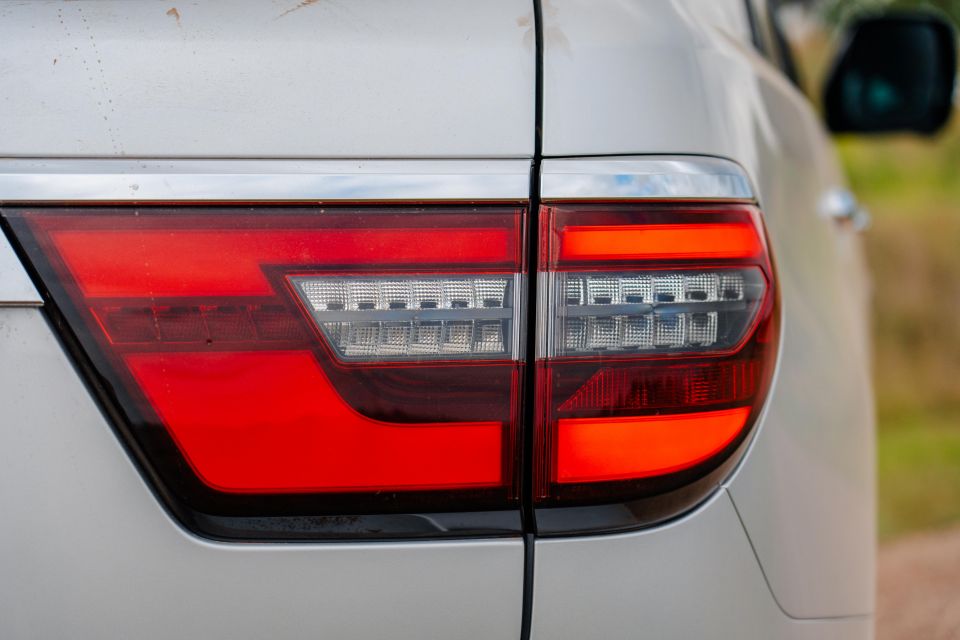
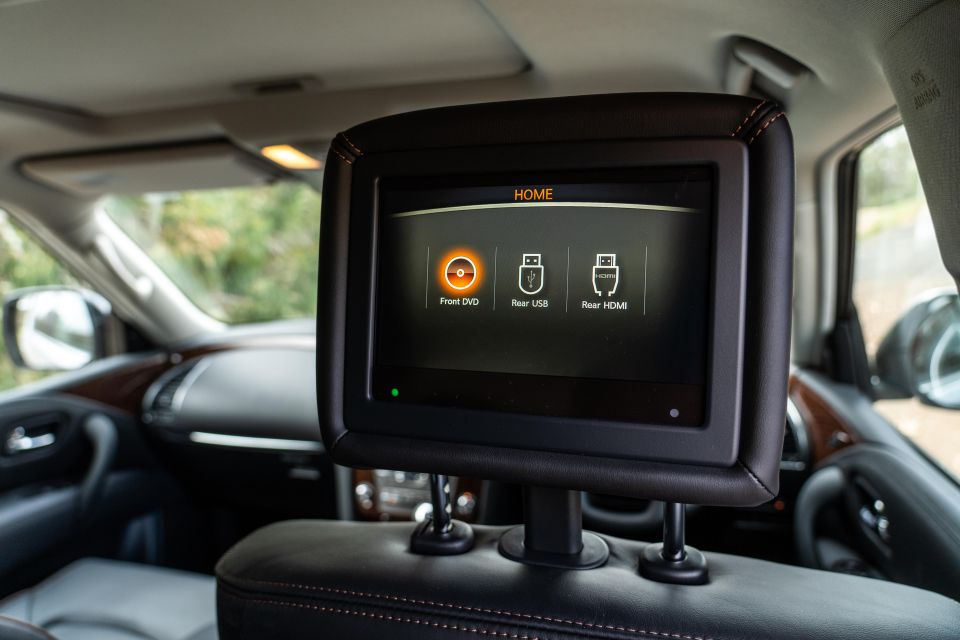
Patrol Ti-L highlights:
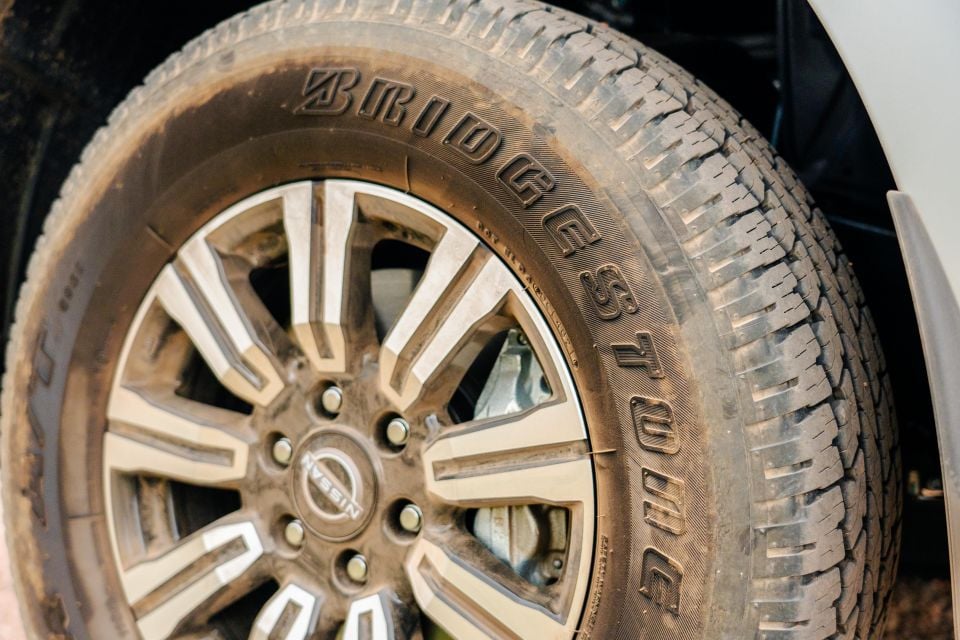
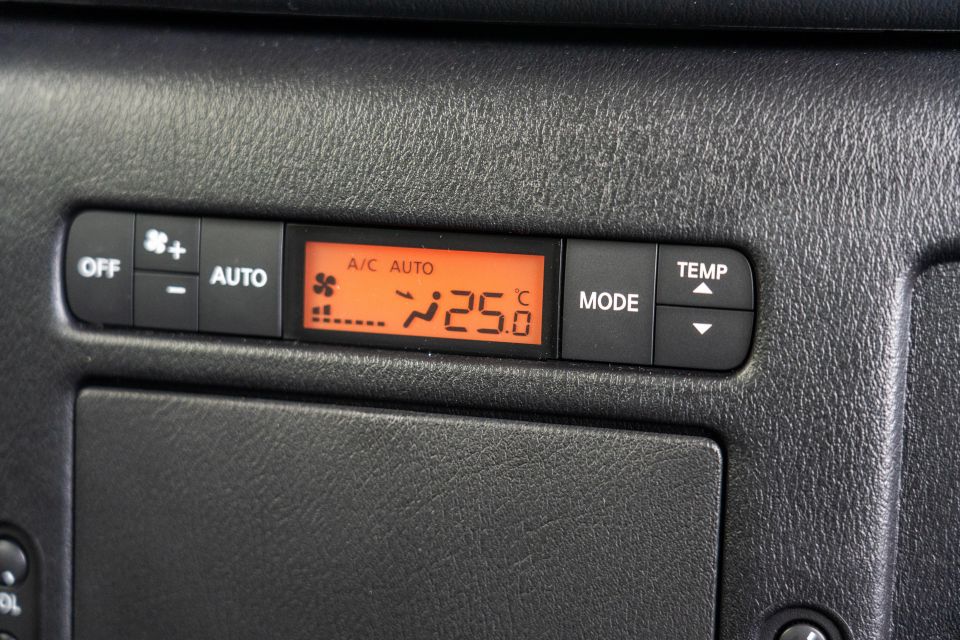
That’s on top of the Patrol Ti’s standard features:
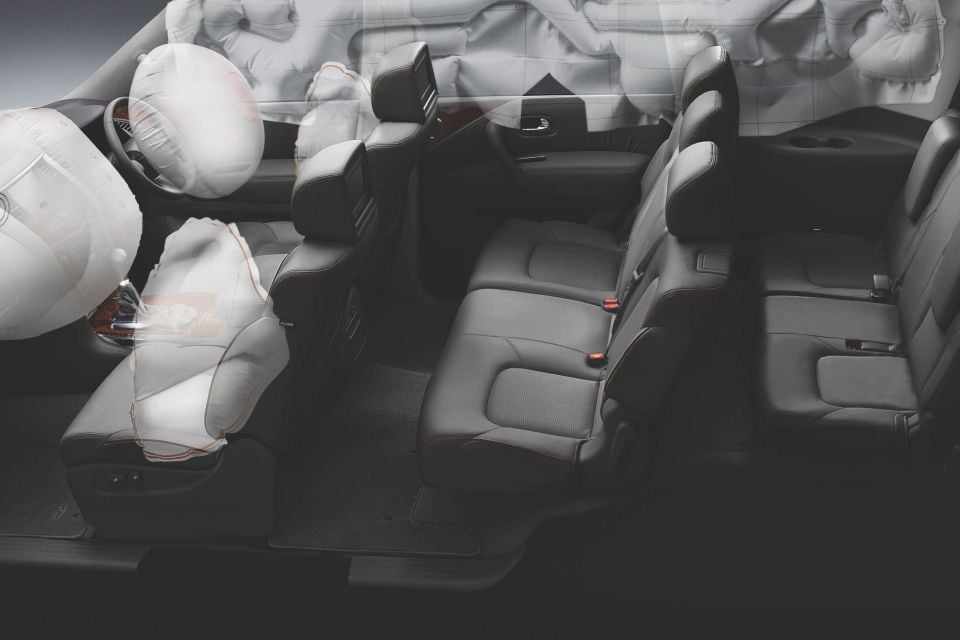
The current-generation Nissan Patrol hasn’t been rated by ANCAP in pre-facelift or 2022 guise.
Standard safety features include:
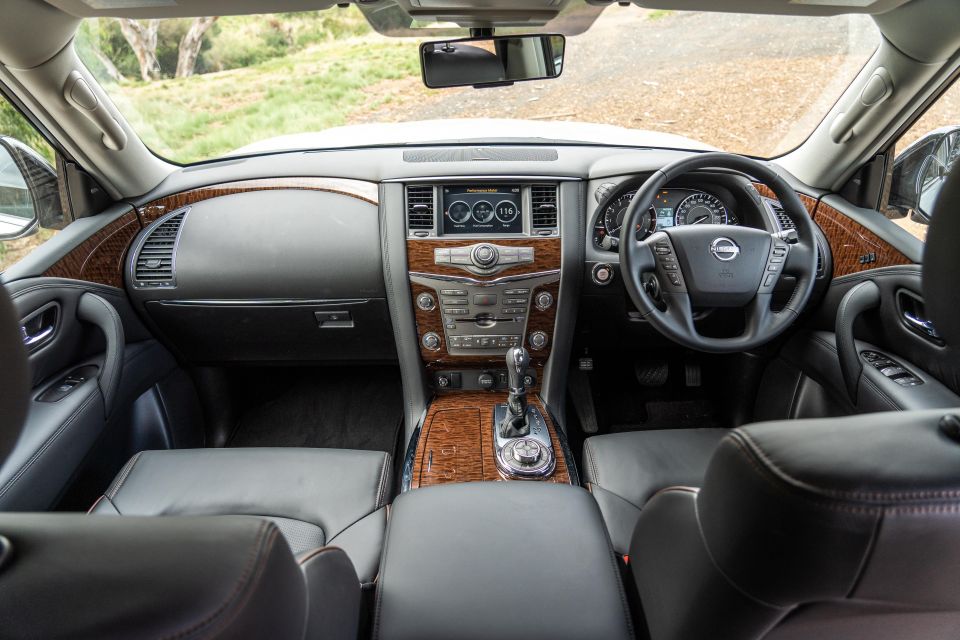
If I was to liken the Patrol’s interior to something, I’d go with an old luxury hotel.
Lined with shiny woodgrain and swathes of leather, the Patrol’s cabin is luxe in a very ’90s way. Some will find it charming, others may consider it dated and gauche.
Even more dated is the infotainment and the instrument cluster – I’m pretty sure nothing has changed since this generation of Patrol launched globally in 2010.
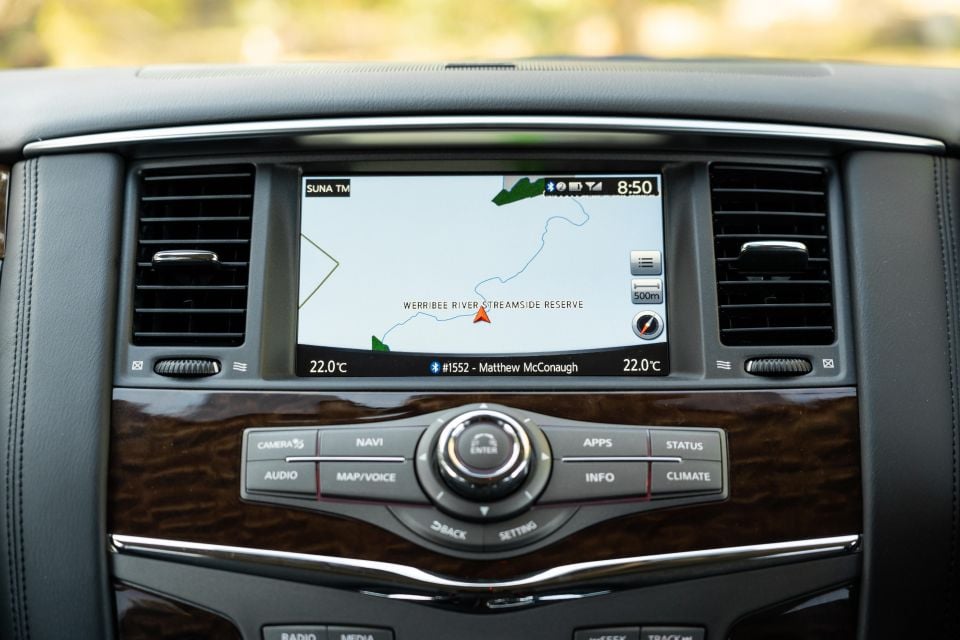
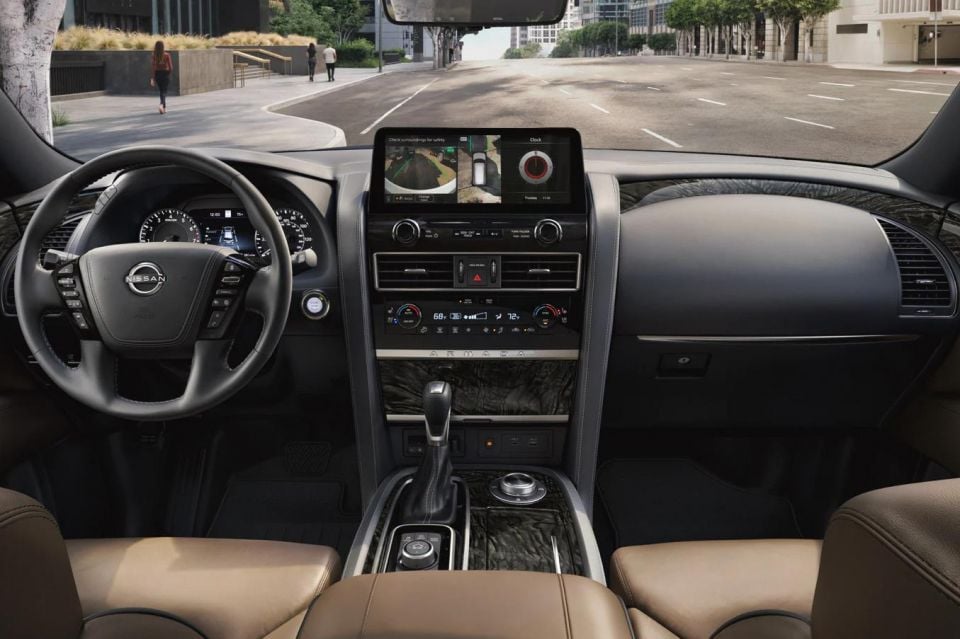
The interface is at least two or three generations old, and the satellite navigation maps looks like it’s been borrowed from my parents’ 2009 Subaru Tribeca. Ahead of the driver is a monochrome LCD trip computer display which doesn’t even offer a digital speedo readout.
It’s even more disappointing given left-hook versions of the Patrol (known as the Armada in some markets) get a more contemporary cockpit with newer screens and software, as well as Apple CarPlay and Android Auto compatibility, the latter a glaring oversight from Nissan in 2022.
The Patrol’s age is further evident in the more is more approach to buttons and switchgear, as well as the orange backlighting. Don’t get me wrong, everything feels solid and well-built here, but it feels incredibly dated.

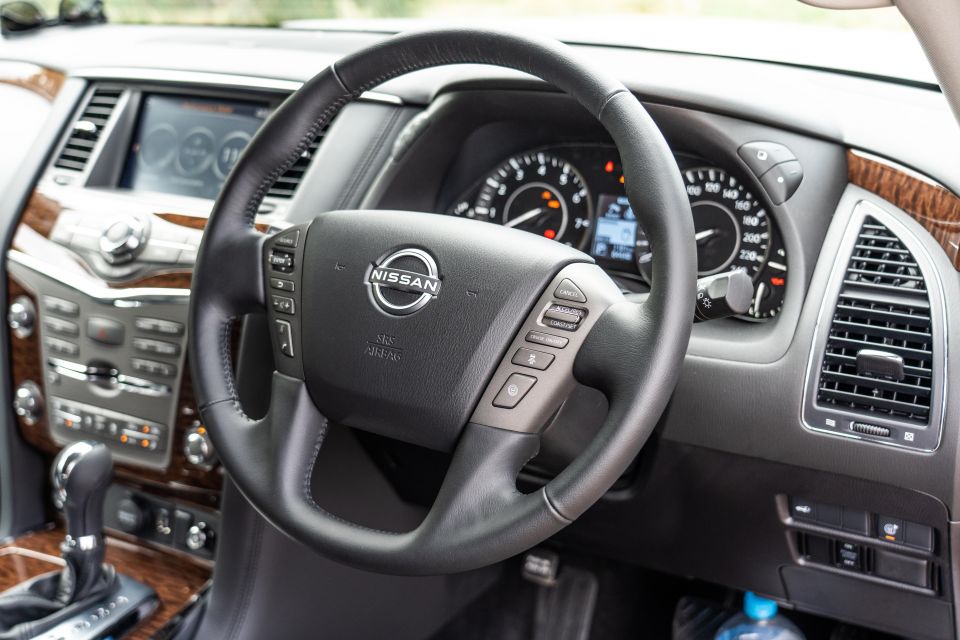
Tech complaints aside, the Patrol’s front row is comfortable and well-made, with supple upholstery and a wide range of electric adjustment for the seats and the steering wheel in the Ti-L. Memory presets for the seats and steering wheel also feature, which is handy.
The stack of buttons on the centre console can be confusing at first given there’s just so many, but you quickly learn what lives where and there’s an on-board voice assistant that can make phone calls or enter navigation routes so you don’t have to go diving through the menus of the laggy touchscreen.
Storage isn’t great. There’s two cupholders and a small cubby between the front seats, as well as a cooled box under the front-centre armrest. The door pockets can accommodate a larger bottle, but that’s about it.
Clearly the Patrol wasn’t designed to store massive phones like my iPhone 13 Pro Max, and there really isn’t anywhere convenient to put a phone that size unless you leave it in your pocket. I ended up getting a cheap vent mount so I had somewhere to show Apple Maps or Google Maps when I didn’t trust the native navigation system.
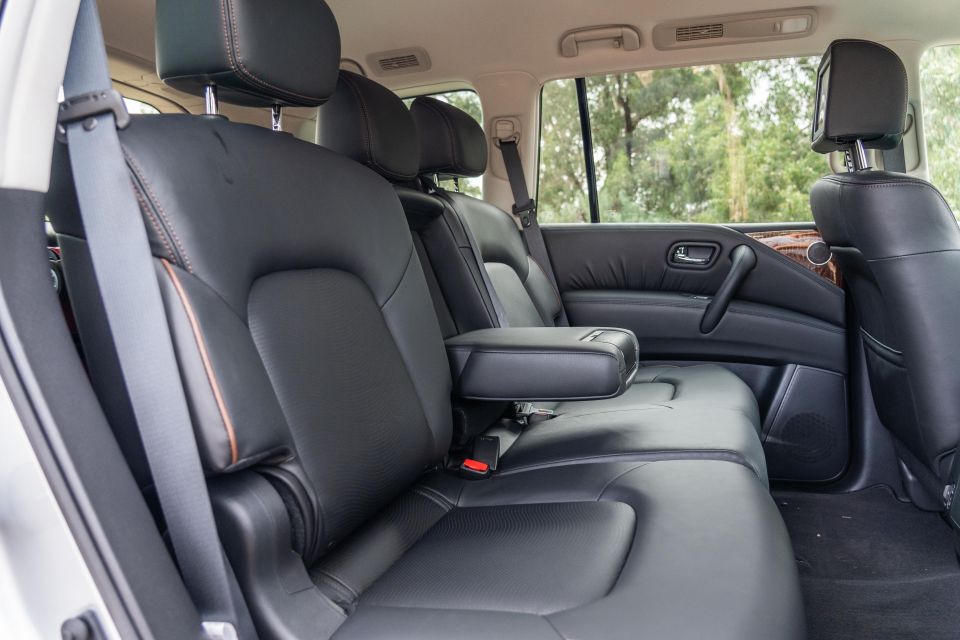

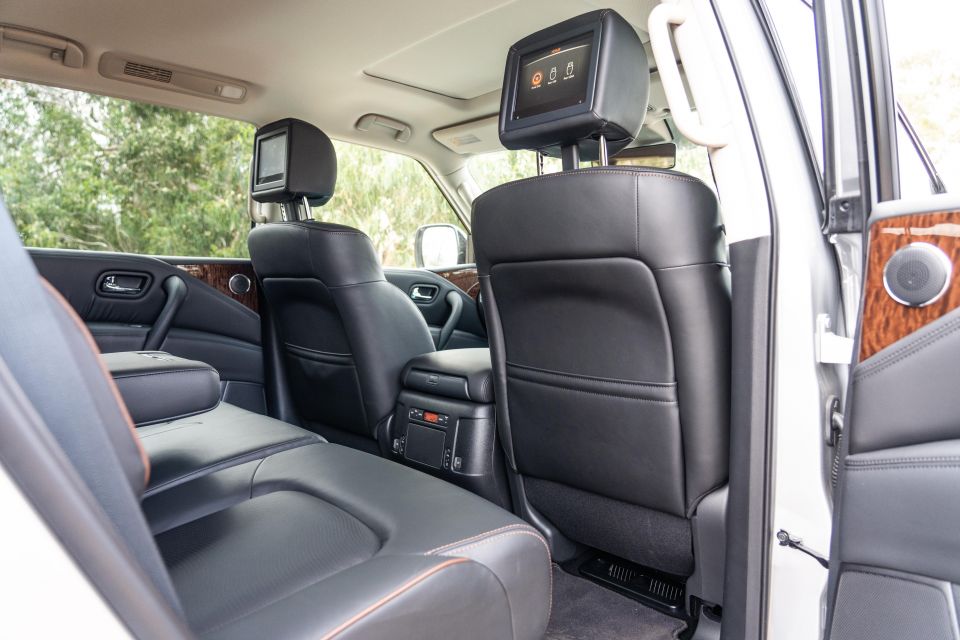

Second-row accommodation is very generous, as you’d expect from a vehicle measuring 5175mm long with a 3075mm wheelbase.
The seats are comfortable, and the bench is nice and wide so seating three across shouldn’t be much of a squeeze. There’s rear climate controls, a dual-screen entertainment system and a fold-down centre armrest.
Bolstering those items are map pockets behind both front seats, bottle holders in the doors, and a recline function for the second-row seatbacks. There’s ISOFIX anchors on the outboard positions, with top-tether points on the outboard pews as well as the driver’s side seat in the third row.
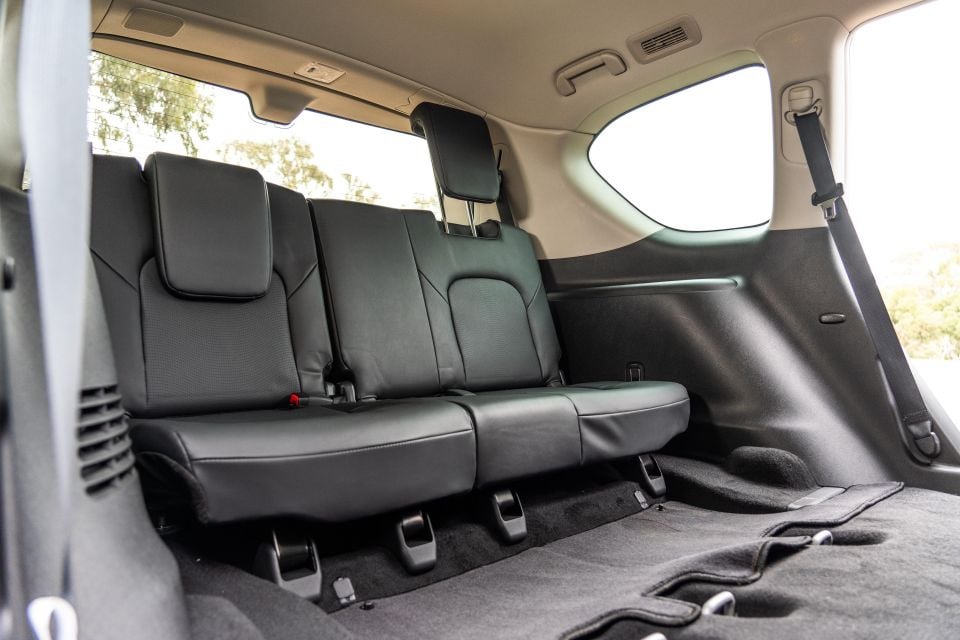

Speaking of the third row, the Ti-L has two seats rather than three in the Ti. That said, the skinny centre pew in the base model would only really be of use for small kids anyway.
As demonstrated by Paul in the video, third-row space is quite tight for adults, particularly if you’re long-legged.
Given the second row doesn’t slide fore and aft like you’ll find in some other SUVs, you can’t free up more space in the third row. Given there’s a decent amount of room behind the third row you’d think Nissan could have shifted the seating back by a few millimetres.
You can, however, recline the third row seats to be less upright if you so desire.
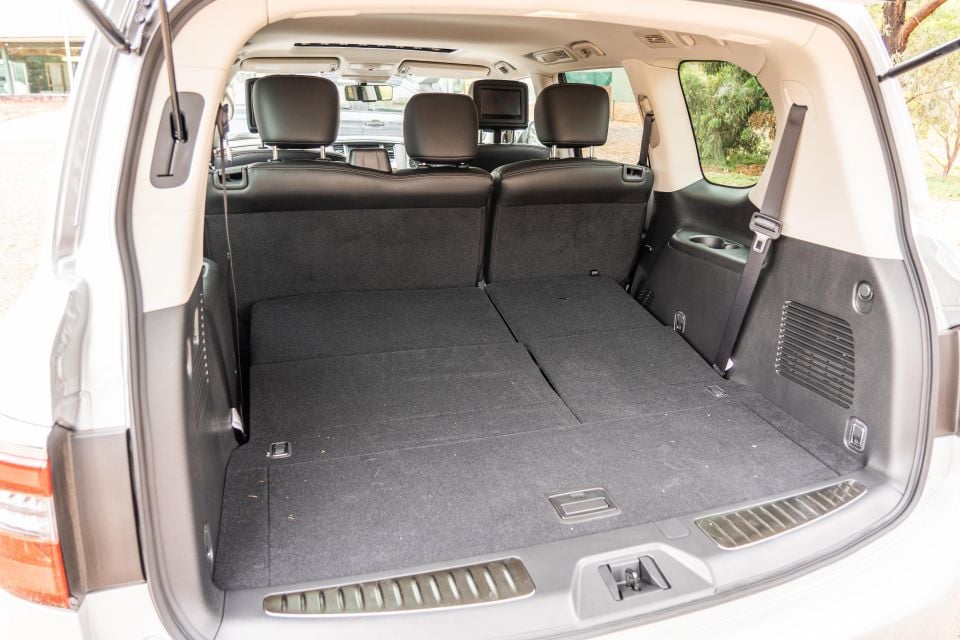
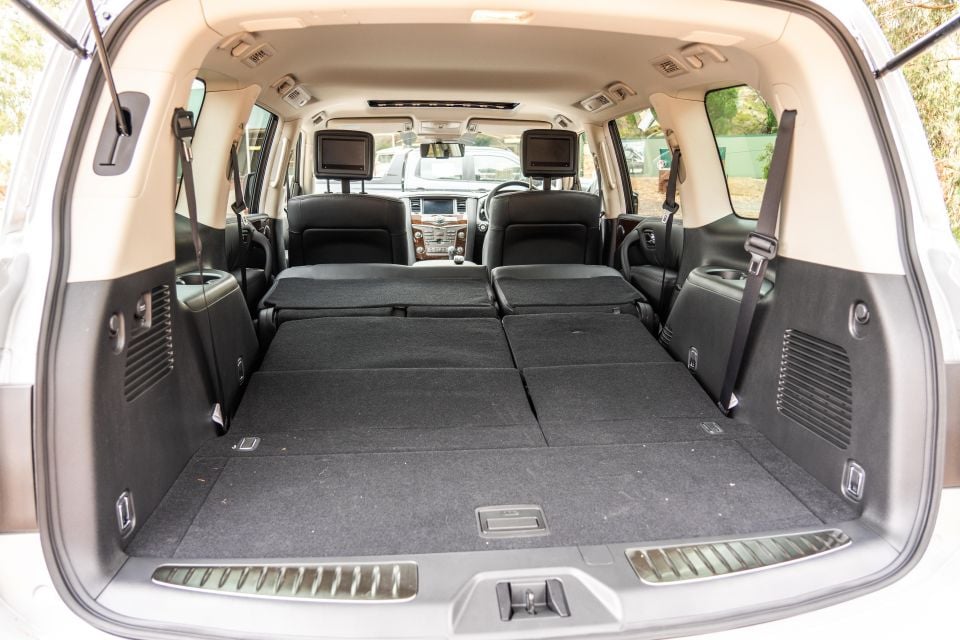
Simply put, the boot is huge.
With all three rows in play there’s 467L on offer, expanding to 1413L with the third row folded – these measurements are to the roofline not to the top of the seatbacks. Tumble the second row and there’s 2623L.
Worth noting is that the third row doesn’t fold completely flat, and there’s a bit of a gap between the third-row seatbacks and the second-row seat bases when you tumble them forward.
A full-size alloy spare wheel lives under the rear of the Patrol.
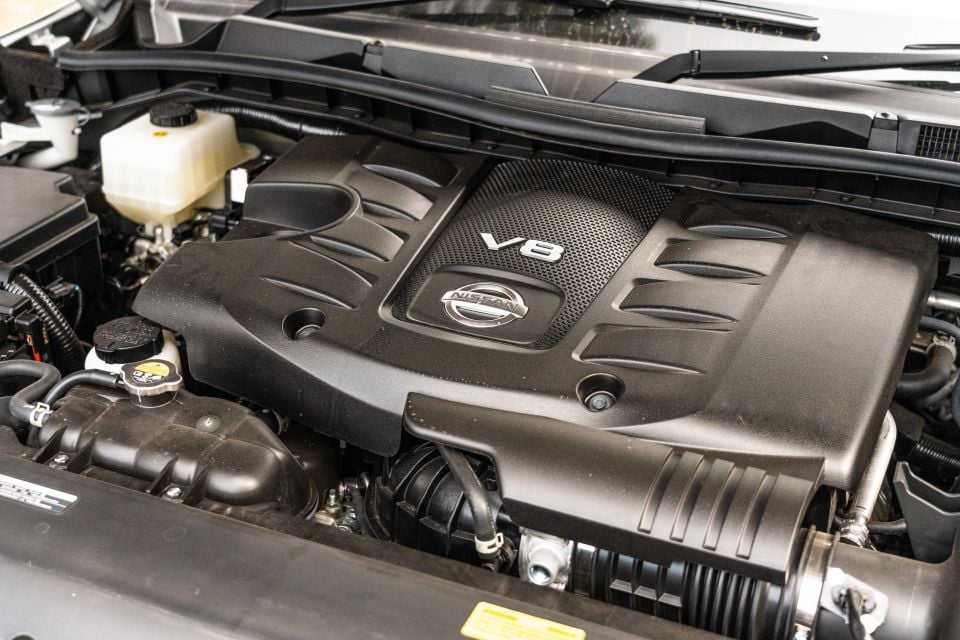
All versions of the Patrol are powered by a big ol’ 5.6-litre naturally-aspirated V8 petrol engine, with outputs quoted at 298kW (5800rpm) and 560Nm (4000rpm).
The direct-injection motor is paired with a seven-speed automatic transmission as standard, channelling drive to a full-time 4×4 system with low-range, terrain modes and hill descent control.
Combined fuel consumption is rated at 14.4L/100km with 95 RON premium unleaded required as a minimum for its hefty 140-litre fuel tank.
Nissan quotes a maximum 3500kg braked towing capacity with 350kg towball download limit, while the Gross Combined Mass (GCM) is rated at 7000kg.
While the Toyota LandCruiser 300 quotes the same 3500kg towing limit, its GCM across all variants is 250kg short of the Patrol at 6750kg – though in most specifications the LC300 is at least 100kg lighter (Patrol Ti-L weighs 2750kg tare, LC300 at its heaviest is 2630kg kerb).
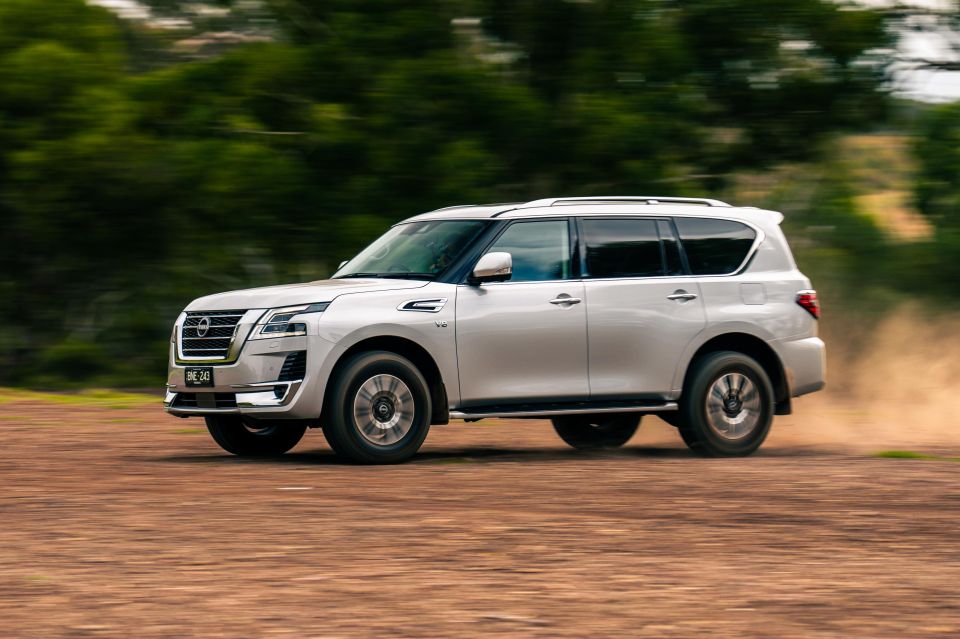
Having recently stepped out of the twin-turbo diesel-powered LandCruiser 300 Series, the Patrol feels like a very different beast from the moment you press the starter button.
It fires up with that distinctive V8 petrol growl but then quickly settles into a muted, subdued burble. There’s an old-school feel to it, in a good way. That old-school feel carries over to the bulk of the drive experience, too.
Being a big, bulky ladder-frame SUV with a heavy V8 engine up front, the Patrol feels as large as it looks from behind the wheel.
The light steering and noticeable body heft makes the Patrol feel like a land yacht, but that’s not to say it’s cumbersome or uninspiring to drive – in fact it’s probably the opposite. It’s quite a bit of fun.
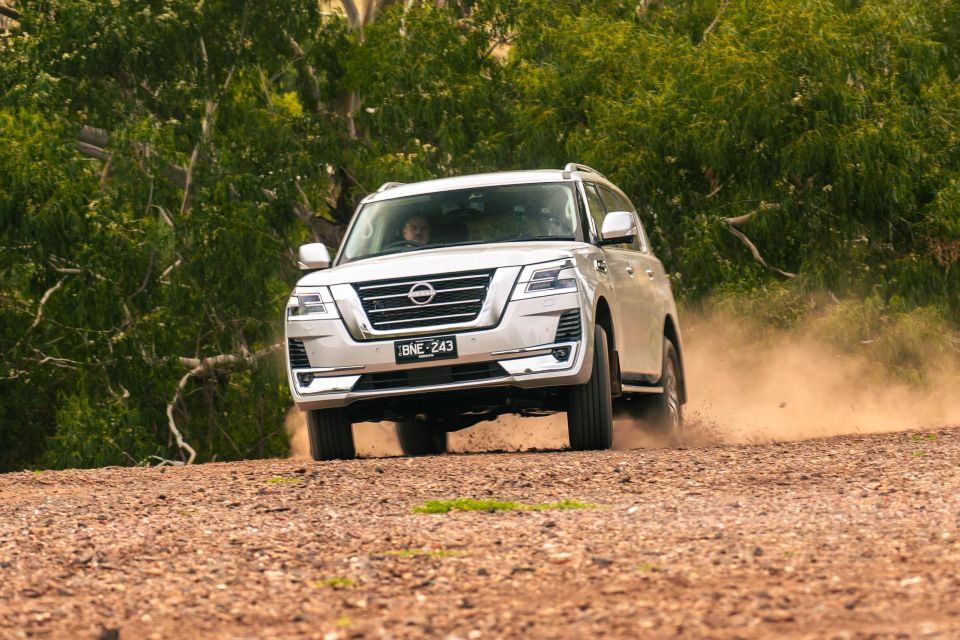
Find out more about the car
You feel like you’re the King of the Road in this thing, possibly more than you would in the LandCruiser because of the Nissan’s heft. A commanding driving position, light driver controls, and that petrol engine make the Patrol charming, with that V8 growl putting a smile on your face whether you’re in town or roaring up to freeway speeds.
The steering is a little light and numb, but you don’t find yourself misjudging inputs around the city or parking. You just need to account for the size of the vehicle.
Outward visibility is excellent courtesy of the vast glasshouse and large side mirrors, and there’s the added safety net of blind-spot monitoring, rear cross-traffic alert, and a surround-view camera system.
The 360-degree camera looks good on paper, but it’s is grainy at best and doesn’t give the best view of your surroundings, especially given the tiny display. There’s also a rear camera projecting a live feed into the central mirror if you’re fully loaded for enhanced rearward visibility.
On the move the Patrol is comfortable and refined. I did a week of peak-hour commuting, and felt like I was in a second-storey cabin given how tall I was over traffic. Tyre noise is kept to a minimum and wind noise is well suppressed given the upright proportions and Dumbo-like wing mirrors – though at speed, or on a particularly windy day you will notice some noise from the B-pillar and mirrors.
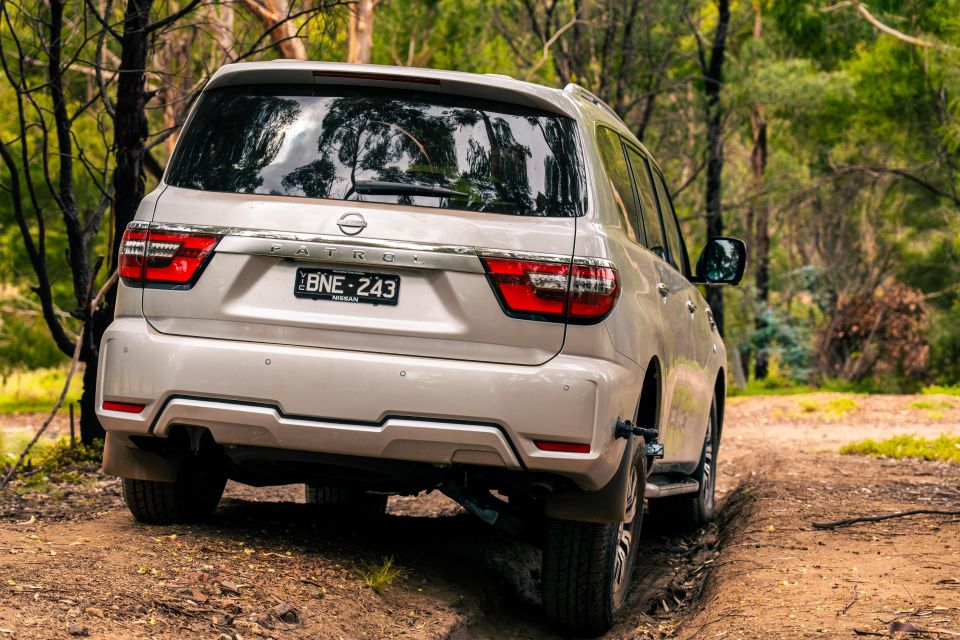
The Patrol is very stable at highway speeds. The vague steering off-centre means you may find yourself constantly making tiny adjustments to keep the Patrol on the straight ahead, but it’s nothing too tiresome.
At 100km/h the drivetrain sets into a silent hum in seventh gear, quickly kicking down a cog or two if you need to make a quick overtake.
Performance is mostly great, with smooth acceleration and great throttle response. Paul Maric, has managed a sub-7.0-second 0-100km/h time which is nuts for a vehicle this size. It feels quick too.
With that said, a road trip out to Lake Eildon in Victoria’s outer north east showed that the Patrol doesn’t quite have the effortless performance you might expect of its outputs. Undulating roads and tight corners meant the transmission was shuffling through gears to get the revs up and get into the torque band, which is fun but doesn’t help refinement or fuel consumption.
I can only imagine that with a fully loaded cabin and/or with a trailer on the back, the engine and transmission would be worked quite a bit. It also doesn’t help there’s no paddle shifters, though there’s a sport shift function via the gear shift which allows you to change ratios manually.
It was surprisingly responsive through Victoria’s Black Spur.
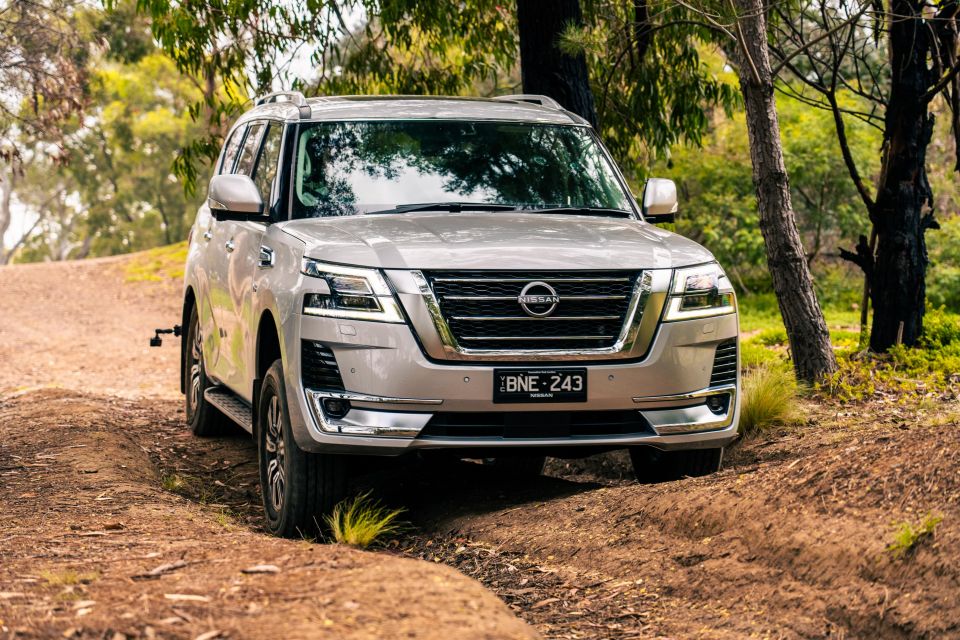
It rides beautifully too, with excellent body control over road imperfections regardless of speed and terrain no doubt helped by Nissan’s Hydraulic Body Motion Control (HBMC) suspension system.
The Patrol settles nicely over undulations. Despite being over 2.7 tonnes and riding a lofty 273mm above the ground, it handles well enough and doesn’t roll about like you might expect. It feels grippier and more settled in corners than the LandCruiser 300 Sahara I stepped out of recently as well.
As for assistance systems, the Patrol features adaptive cruise control which works well (though a digital readout of the set speed would be nice), and the blind-spot and rear cross-traffic systems are handy.
Nissan’s lane-keeping isn’t quite as sophisticated as some systems now available in rivals, including the LandCruiser 300 – but it’s at there to nudge you away from the lines via braking or sound a beep to let you know you’re drifting.
While I found it to be a little flawed, the Lane Trace Assist (active centring) function in the Toyota LandCruiser is a handy feature for a vehicle so large.
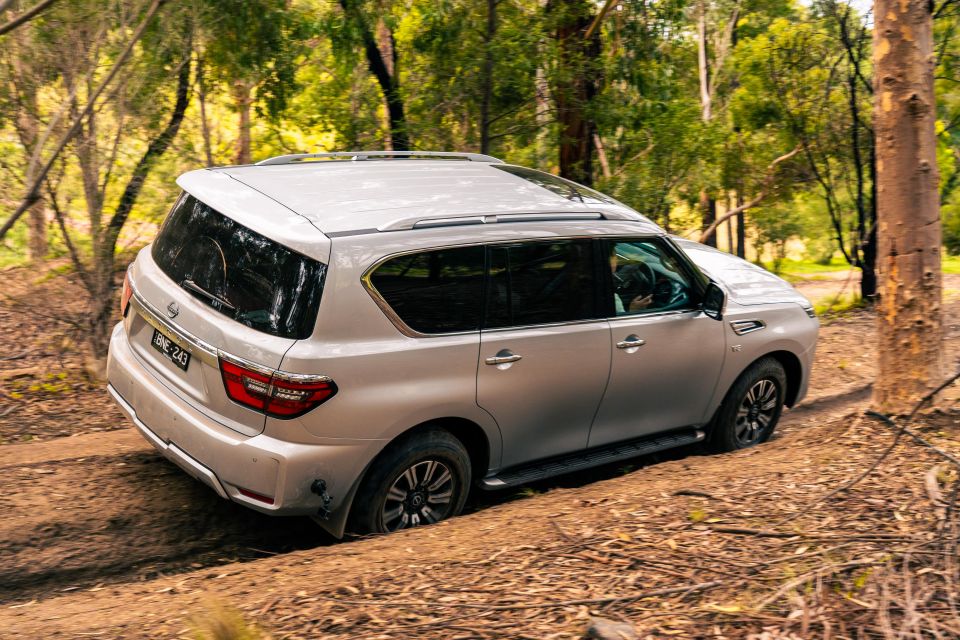
Head off the black stuff and the Patrol again shows off a broad skillset.
With permanent four-wheel drive, a low-range transfer case, locking rear differential and a number of terrain modes to go with that lofty ground clearance, the big Nissan really does feel like it can go anywhere.
On our off-road course the Patrol offered good traction despite some loose surfaces. In 4H the throttle can be a little too sensitive, but that’s easily fixed by engaging low range for more measured, progressive response better suited to off-roading.
The Patrol handled the offset mogul, log climb and rocky descent with finesse, and we’re confident it could do most of what target buyers demand straight out of the box. Should you need more, there’s plenty of aftermarket modifications and solutions to make the Patrol even more capable.
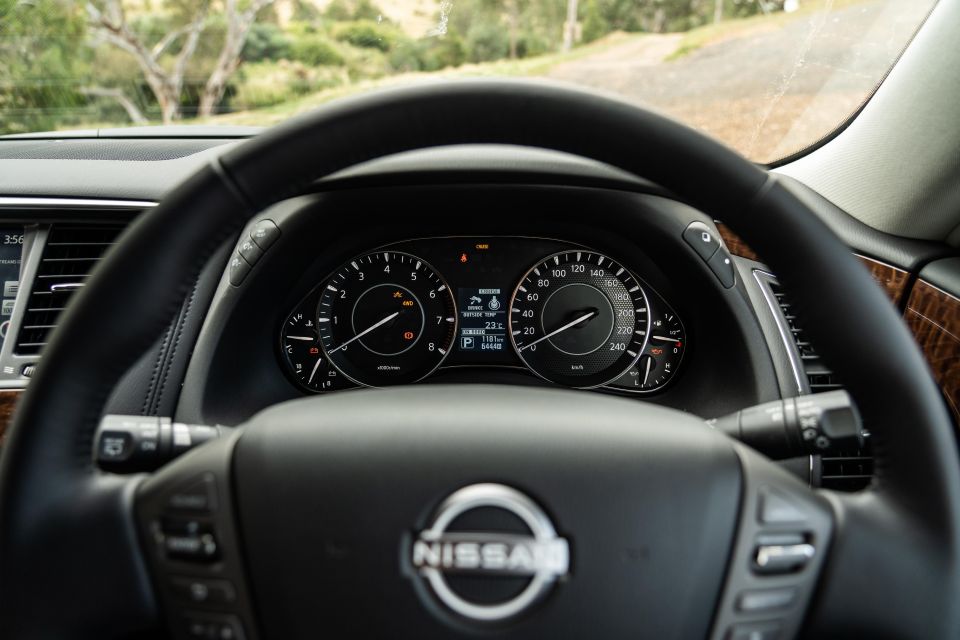
All of Nissan’s models are covered by a five-year, unlimited-kilometre warranty.
Scheduled maintenance is required every 12 months or 10,000km – whichever comes first. Nissan offers capped-price servicing for the first six scheduled visits.
At the time of writing, advertised pricing per visit is $393, $502, $483, $791, $425 and $622. You’ll spend at least $3216 for servicing – though that doesn’t include replacement of brake fluid every two years or 40,000km, which is $47 a pop including GST.
Real-world fuel consumption is another hefty hit to the pocket. We averaged an indicated 15.2L/100km over a week of testing which included peak-hour commuting to and from the city-based Melbourne office, as well as a weekend trip to Lake Eildon in Melbourne’s outer North East.
Before heading out for my weekend road trip the Patrol had largely dealt with commuting, which included a decent freeway stint en route, but the trip computer was showing 17.2-17.5L/100km.
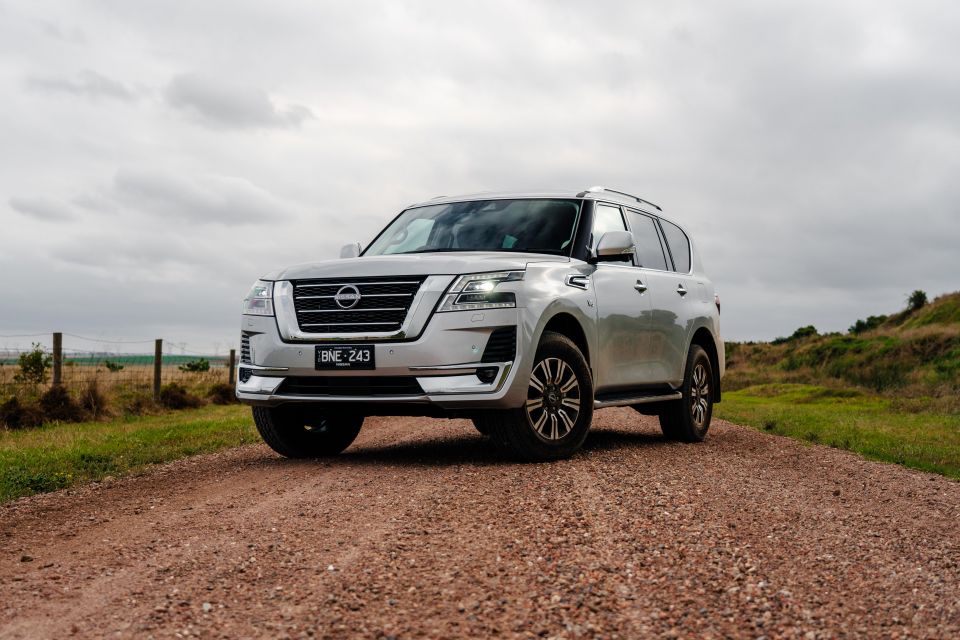
If it were a child of the animal kingdom, the Nissan Patrol would be described as a ‘living dinosaur’.
Just about every aspect of this car is a throwback, from the drivetrain to the design and interior appointments. It’s really starting to show its age.
But that’s precisely the appeal, even a decade on from this generation’s initial launch. It’s for the type of person who isn’t persuaded by downsizing, turbocharging, or the latest tech.

The Patrol is in your face and proud, and does what it says on the tin. It’ll go just about anywhere, and carry just about anything – as long as you don’t run out of fuel on the way.
For what it’s worth, you can have a decked-out Patrol for less than a one-up-from-base LandCruiser 300 GXL and not have uncertainty around delivery times. Relative to competitors, it’s something of a bargain.
It’s just a shame we don’t get all the developments and updates to the cabin like left-hand drive markets, because it would be a much more complete package if it did.
C’mon Nissan, give us Apple CarPlay and a digital speedo to go with those new badges, I beg you.
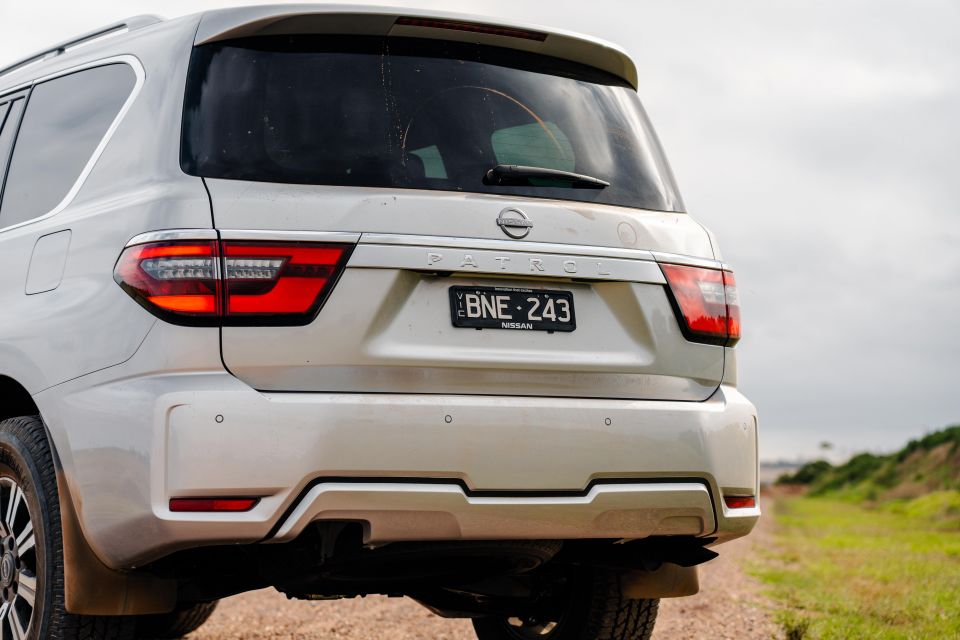
Click the images for the full gallery
MORE: Everything Nissan Patrol
Take advantage of Australia's BIGGEST new car website to find a great deal on a Nissan Patrol.
James is an automotive journalist based in Melbourne, Australia. Before joining CarExpert.com.au in 2020, James has worked at leading auto media outlets including Carsales and CarAdvice, as well as at Pulse agency for Ford Australia's communications team. In 2019 James made Mumbrella's 'Top 20 most prolific web authors in Australia' list after publishing 1,360 articles between March 1, 2018 and February 28, 2019 for CarAdvice. James is also an Ambassador for Drive Against Depression – an Australian charity whose mission is to support mental wellness through the freedom of driving and a shared love of cars.


William Stopford
3 Months Ago
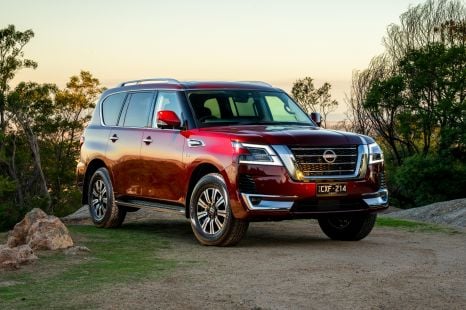

James Wong
2 Months Ago


Gautam Sharma
2 Months Ago
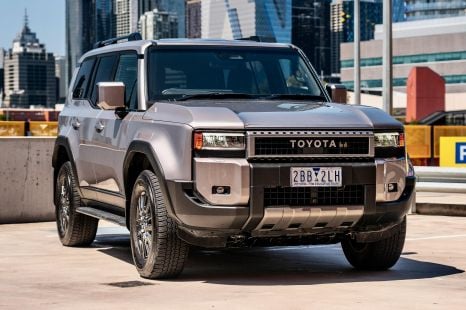

Max Davies
1 Month Ago


Matt Campbell
16 Days Ago
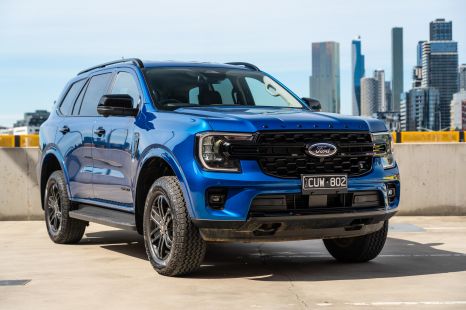

Josh Nevett
11 Days Ago